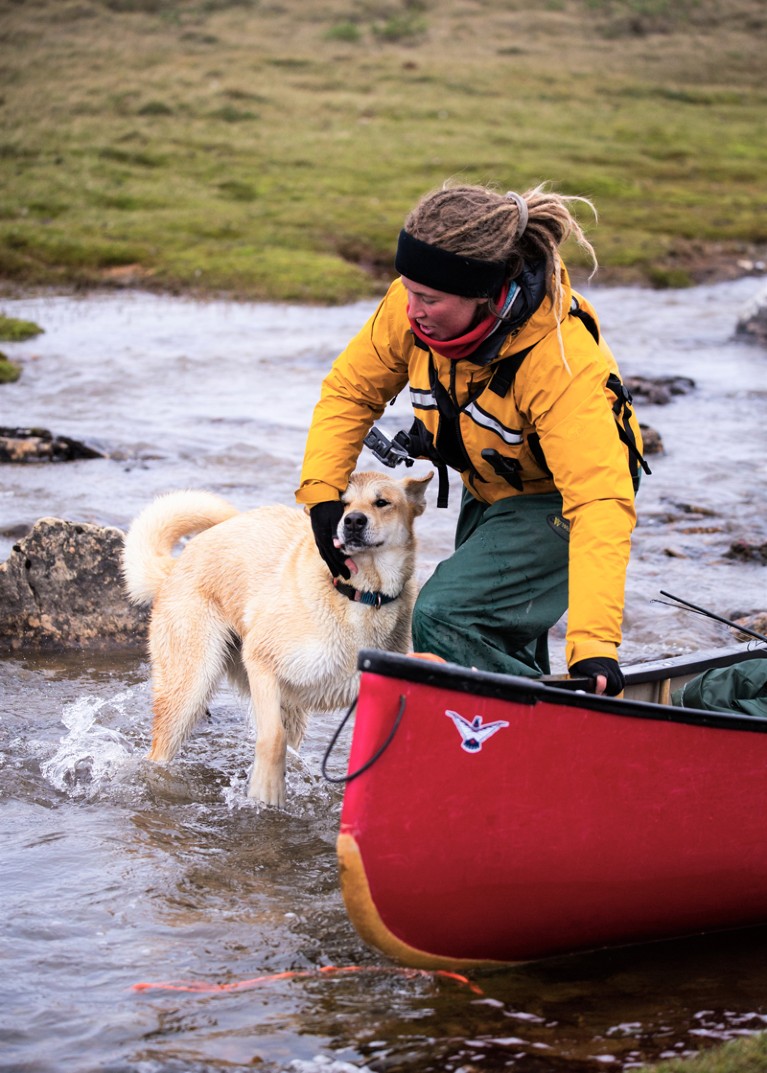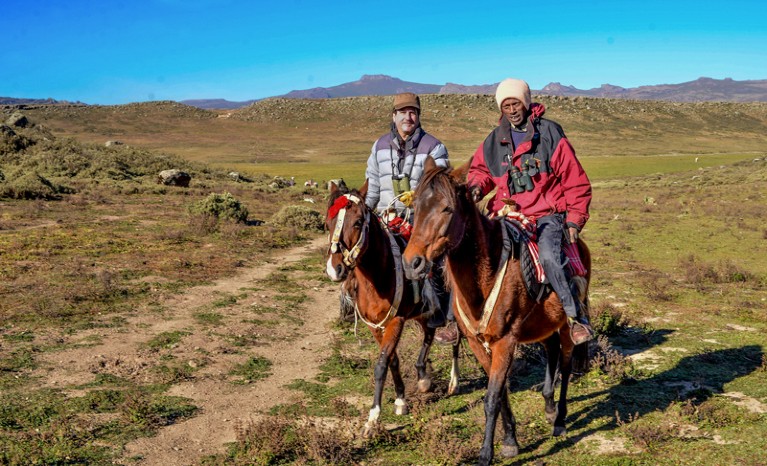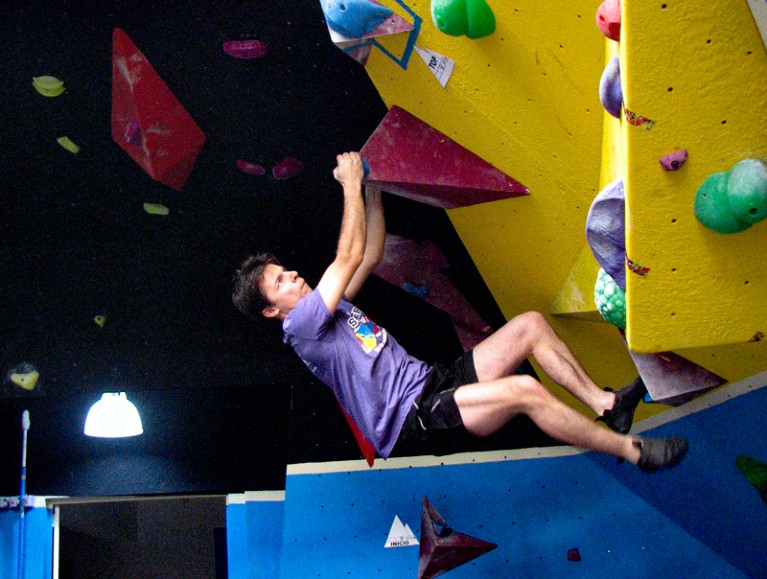One summer evening in 2004, around the campfire during a rock climbing trip to the Red River Gorge in Kentucky, Doug Benn, a glaciologist at the University of St Andrews, UK, shared a photo with Jason Gulley. It was a picture of a 6-metre-deep hole, shaped like an upside down ‘L’ in the walls of the Khumbu Glacier, the highest glacier in the world at an altitude of 7,600 m on the southwestern slopes of Mount Everest in Nepal. Then a final-year undergraduate geology student at Eastern Kentucky University in Richmond, Gulley thought that the hole’s shape looked like the result of meltwater drainage, which hinted that long, intricate caves can form and melt in glaciers. But, it would be impossible to work out exactly how those processes happen without getting inside these voids.
So, the two dreamt up what some might consider to be an outrageous plan. Gulley, now a geologist at the University of South Florida in Tampa, decided to learn to ice climb so that he could explore the insides of the world’s highest glaciers. Gulley already had experience caving and underground diving, but that wasn’t enough for expeditions that would require specialized technical skills for the extreme environmental conditions. So, he started taking regular trips, driving about 15 hours to Batchawana Bay, Canada, to learn ice climbing.
A year later, Gulley, Benn and their colleagues climbed and crawled along narrow, dark passages with only a headlamp, to explore and map the tunnels inside glaciers that sit at an altitude of around 5,000 m in the Himalayas. “I realized that I might be able to combine exploration and research into a career,” says Gulley. “Our research showed that glacier caves in the Everest region are literally rotting glaciers from the inside out and they form as a direct result of a warming climate.”
Indeed, many research projects or data-collection tasks require scientists to learn unusual, extreme or very technical physical skills that go beyond the typical field-work duties of setting up a tent or driving an all-terrain vehicle. Nature spoke to enterprising scientists who were willing to learn such skills. They describe how they did it, both mentally and physically, why safety is paramount and how their new talents opened up research avenues.
Scientists applying high-stakes skills for research fieldwork can face injury, equipment failure, extreme weather or vast and harsh environments. Researchers, therefore, must prioritize safety, enrol in professional training courses when available and not push themselves past their limits. But with the right training and precautions, they can be flexible and quick thinkers when the unexpected happens.
Steep learning curves
It’s exciting when a challenging adventure can also be the key to answering your research questions, says Krzysztof Gaidzik, a palaeoseismologist at the University of Silesia in Katowice, Poland, who studies ancient and active earthquakes. He learnt to rock climb to explore granite formations during his PhD fieldwork near the border of Poland and the Czech Republic.
“Research and adventure goals must always go together in balance,” says Gaidzik, who has learnt several extreme adventure skills to support his research. He says it’s important for researchers to constantly practise and hone their skills to be ready for surprises on expeditions. At the same time, researchers should respect the adrenaline rush and recognize when it could push them to take risks that might distract them and jeopardize their research goals or safety.
In 2008, Gaidzik began visiting Colca Canyon in southern Peru, one of the world’s deepest canyons at around 3,400 m, to study ancient earthquakes and active tectonic structures. While collecting data, he realized that the ruggedness of the landscape sometimes limited his access to sites of interest. So, he learnt to snorkel to reach rocks submerged in deep river water. “I’m currently planning to learn to paraglide to land in difficult-to-reach places,” he says.
Elise Imbeau, a biologist and co-founder of Viventem, a scientific support agency for Arctic research in Cambridge Bay, Canada, uses canoes to guide research teams across the Canadian Arctic Archipelago’s rivers and lakes. These teams might study marine and freshwater fish, kelp-forest biodiversity or freshwater invertebrates. She also guides teams in fields outside her specialty, such as polar chemistry and geology.

Elise Imbeau with dog Shila, who looks out for polar bears on canoe field trips in the Arctic.Credit: Dani Nowosad
And when it’s too difficult for teams to collect samples, Imbeau and her partner, who have run the agency since 2020, take up the mission. Some groups of researchers use helicopters to access hard-to-reach sites in the region. But not everyone has the budget. “We thought, why not try it by canoeing, and the idea proved successful,” says Imbeau.
Imbeau already had experience kayaking and white-water rafting, but those skills weren’t cut out for the Arctic expeditions. Using an inflatable canoe, Imbeau began by practising canoeing through ice patches near the coast to reach the middle of half-frozen lakes and seas, where the ice cover is thick enough to walk on. She had to learn to make perfect forward strokes in the unwieldy inflatable — positioning the paddle blade in such a way that it pulled water efficiently for maximum momentum. She also learnt how to do capsizing self-rescue techniques to get back into the canoe if help is not available. “When guiding teams,” says Imbeau, “we teach them the basics of canoeing, and stay close to make sure they are paddling safely.”
Claudio Sillero, a biologist at the University of Oxford, UK, has been leading the Ethiopian Wolf Conservation Programme (EWCP) since the late 1980s to monitor these endangered animals. Growing up on a farm in Argentina, Sillero spent time around horses, but was not an expert rider. When he saw the nomadic Oromo people in Ethiopia riding horses while herding livestock, it struck him that riding would help him to cover the roughly 2,000-square-kilometre range of mostly rugged terrain, where wolf packs roam. Each trek covering the range takes a week of travel on horseback.

Claudio Sillero (left) and his colleague track wolves on horseback in Ethiopia.Credit: Claudio Sillero
Sillero says that riding took him to places that he couldn’t reach otherwise because of cliffs and the lack of roads. His desire to track the wolves effectively drove him to develop his riding skills so he could canter and gallop on steep terrain. EWCP owns a collection of horses and Sillero’s team of research associates and students learn riding basics. “We can cover not only a larger range but also achieve the closest distances,” to the wolves, says Sillero. Unlike when researchers are on foot, he explains, the “wolves don’t react with fear or flee when we approach on horses, but rather ignore us,” he says. This is because no one hunts them on horseback, he notes.
Safety first
Wild animals can pose a significant threat, however. “I boat up on the Beaufort Sea, north of Alaska, and constantly look out for polar bears, they are a real threat,” says Noelle Helder, a marine scientist at the University of Alaska Fairbanks. Imbeau notes that her teams “take trained dogs to alert us by barking when any polar bears come close”.
How researchers in remote regions handle the isolation
Helder wasn’t that into marine sports before she began her career studying marine biology at the University of South Florida in Tampa, where she learnt to scuba dive and sail, and began working on a variety of marine research projects across the Caribbean. Helder and her colleague once ended a research dive to map coral reefs when an intense thunderstorm began to form. They immediately returned to the boat to find its batteries dead. The situation became tense as the waves, wind and thunder increased, until the researchers finally flagged down a passing boat. Although they returned safely to shore after abandoning their own boat, “it was a reminder that things can change very quickly when you’re working on the water”, says Helder. Currently, Helder maps the effects of climate change on Alaska’s coasts and coral-reef ecosystems.
Working on water brings not only rapidly fluctuating weather, but also strong winds, shifting tides and currents. “Before going out to work in the field, we list the potential risks for a range of emergency scenarios, including rapid-response plans for accidents and sudden natural conditions,” says Imbeau.
Both Imbeau and Helder usually work on water during the milder months. But even in warmer seasons, the water temperature remains dangerously cold, around 0–7 °C, and so exposure can be life threatening, with loss of consciousness occurring within 15–30 minutes of immersion. Imbeau says that researchers can reduce risks by wearing drysuits, checking the detailed weather forecast and learning how to determine whether the weather is changing. “There are safety procedures that we adhere to, such as communication devices, first aid and an emergency numbers list,” she says. Importantly, she notes, “every time we go to the field, there is someone in town who knows where we are”.
Climbers also must check the weather carefully to avoid windy or wet conditions that can result in falls or falling rocks. Along with a helmet, food, water, a headlamp and a flashlight, Gaidzik makes sure that his bag contains a first-aid kit, a knife, map, compass, a mobile phone and a GPS system for emergencies. “It’s also very important to check and clean ropes regularly,” he says.

Palaeoseismologist Krysztof Gaidzik trains to keep his rock-climbing skills sharp for fieldwork on hard-to-reach active tectonic structures.Credit: Krzysztof Gaidzik
Rock and ice climbers must also constantly assess changing terrain conditions as they climb. Gulley has been in precarious situations that required quick thinking. Once, inside a Himalayan ice cave, Gulley and his colleagues walked onto a false floor of ice, which suddenly collapsed and plunged Gulley into darkness. Fortunately, he only fell about two metres and was unhurt. “I felt like my heart stopped for a moment,” he says.
Even minor injuries or broken equipment can end expeditions prematurely. “It’s important to try not to get into dangerous situations while climbing or diving in an unforgiving environment,” Gulley says, “If something goes wrong, risks would have resulted in real costs,” or worse, the loss of life.
Gaidzik climbs remote rock formations, during which days can go by without seeing locals who could help in an emergency. On one expedition in Colca Canyon for a project on landscape evolution, he was climbing down a steep gorge when suddenly rocks started falling around him. Although the rocks he was tied into above had become loose, the fallen rocks had also made the rock wall beneath him unstable. There was no chance to get down safely: “I realized how dangerous it was and how far away I was from any possible medical help,” says Gaidzik. So, he untied, moved across to a more stable path and climbed back up to the surface.
Riding horses can also be risky, says Sillero. They can be fearful and refuse to pass through narrow paths or walk on steep slopes. If forced, they can rear and throw the rider. Sillero has learnt to calm and reassure horses in such situations. “Developing trust and mutual respect with a horse is essential for safe and successful riding over rough terrain,” says Sillero.
Mental and physical preparation
When applying extreme skills to fieldwork, these researchers recommend regular exercise, adequate sleep and a balanced diet to maintain energy and mental clarity, prevent injury and improve strength and flexibility. Gaidzik brings protein-rich snacks and plenty of water to maintain hydration and body temperature in harsh conditions.
Racing across the Atlantic: how we pulled together for ocean science
He says that part of the mental preparation starts with setting scientific goals as a priority and avoiding distractions that don’t lead to those goals. Furthermore, he says, it’s good to leave your comfort zone and identify fears before heading out on your research expedition. Helder thinks it’s important to ensure there is a culture of safety among the research team. People should feel comfortable speaking out if they feel something is unsafe and know that they will be heard and respected for that decision. “You’re not going to be creative in an environment where people can’t express their concerns or talk to you about safety,” she says.
When Helder began her master’s research in 2019, she already had a certified scientific diving licence, which requires specialized training and qualifications that vary according to the scientific specialization. Scientific divers must attend to all the safety factors required when scuba diving, but also be able to multitask effectively. She also had a captain’s licence to operate diving and trawling boats, which allowed her to participate in research projects at hard-to-reach sites. She says that her previous experience has allowed her to make plans for research, evaluate risks and to make key, quick decisions in the field. “This has definitely opened many doors in my career to new opportunities to work with new people and explore new places,” says Helder.
Her success encouraged Helder to acquire another extreme skill — in 2021 she began training as a long-distance ocean rower. Helder and three other female marine scientists teamed up to win the women’s division of the World’s Toughest Row in 2024, a race in which they crossed the Atlantic ocean in 38 days. “Rowing wasn’t in our skill set when we started,” she says. “But all of our collective experience working in different areas of diving research, boating and being offshore in remote places contributed to us winning.”


